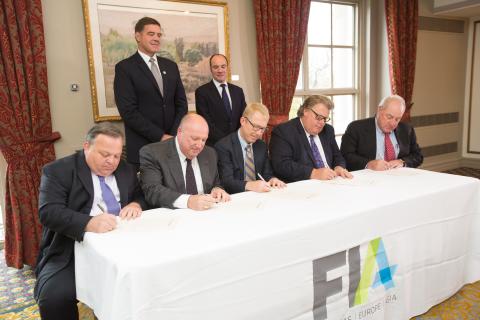Happy New Year and welcome to the first issue of MarketVoice as a newly merged FIA. The merger of FIA Americas, FIA Europe and FIA Asia became official the first week of January, and I’m excited to kick off the New Year as a single organization with expanded member services and a unified voice on global issues.
 The timing could not be better as we engage on a number of critical advocacy efforts that have both regional and global facets, including assisting FIA members in meeting MiFID II implementation, providing the CFTC with feedback on their proposed automated trading rules and preparing for increased mandatory clearing in Asia, just to name a few.
The timing could not be better as we engage on a number of critical advocacy efforts that have both regional and global facets, including assisting FIA members in meeting MiFID II implementation, providing the CFTC with feedback on their proposed automated trading rules and preparing for increased mandatory clearing in Asia, just to name a few.
In this issue, we highlight several industry thought leaders and the “mega-trends”that they are tracking. FIA is also following several broad trends that will impact our industry in 2016 and it’s worth spending some time on these developments.
Health and Stability of the Clearing Ecosystem
This has been an ongoing priority for FIA as our industry has adapted to mandatory clearing requirements post-crisis. As central clearing has become compulsory for many products, new regulations and higher capital requirements are causing dramatic changes in the business model for clearing, making it more challenging for clearing members to continue offering this service. While clearing for certain products may be mandatory, it is not mandatory for clearing members to offer these services, especially when it does not make economic sense to do so. The resulting consolidation in clearing member firms not only makes it more difficult for end-users to access markets and hedge risk, but also reduces the marketplace’s capacity to absorb a default.
Recognizing this challenge, FIA has been working with member firms and industry leaders to ensure the continued health and stability of the clearing ecosystem. We are engaging with policy makers to explain the impact of new regulations and the Basel III capital requirements, and encouraging them to recognize the unintended consequences for client clearing.
Whether it is capital, position limits, reporting or other MIFID II or Dodd-Frank requirements, we must look at the holistic impact of these rules and how they affect price discovery and end-users’ ability to hedge risk. Like all ecosystems, the endangerment of one market species can have dramatic systemic effects on the entire environment. FIA and its staff around the globe will continue to monitor the unintended consequences of these requirements to ensure that these rules aimed to prevent the next crisis don’t unknowingly cause the next one.
Cross-Border Rules Harmonization
As the post-crisis reforms have been implemented around the world, market participants have become increasingly concerned about divergences in the rules from one jurisdiction to the next.
FIA has always believed that our markets work best when capital can flow freely across borders. Yet today, the lack of coordination among regulators makes it more difficult to run global businesses. It can fragment our customer base into separate pools of liquidity, which is detrimental to all markets.
FIA’s single global voice makes us better positioned than ever before to advocate for the harmonization and coordination of market reforms as they are implemented.
Right now, our most active focus is MiFID II implementation. Although it’s a European regulation, it will impact market participants globally. With active staff on the ground in Europe, FIA is assisting the industry in meeting the implementation requirements in a timely manner across a range of key issues, including reporting, investor protection, mandatory trading obligation, non-discriminatory access, indirect clearing, straight-through processing and commodities. Say that three times while chewing gum!
Next on the horizon is the start of mandatory clearing in many Asian nations, from Singapore to Hong Kong to Australia. We’re monitoring the implementation of these clearing mandates and working with policy makers to encourage consistency with global standards. And despite volatility in the Chinese markets last year, we continue to work with government and exchange officials to open Chinese markets in a safe and globally-consistent manner.
Thought Leadership and Best Practices
At Expo this year when I was asked what our members most desire, my response was regulatory certainty. Give us clear standards and rules, and this industry—with its rich history and innovative spirit—will rise up to meet them. It won’t be easy, however. We do recognize that this is enormously challenging in the new global regulatory landscape. But FIA is working overtime to simplify the industry's compliance efforts by organizing implementation working groups and providing helpful tools like our CCP Risk Review, which helps market participants analyze and compare in real-time the rules and procedures of CCPs worldwide.
As our industry's association, FIA has long provided a platform for addressing common issues and developing industry-standard solutions to common problems. Looking ahead to 2016, we see many areas where this work will be needed more than ever.
One example is our work in developing an industry response for the CFTC’s proposal on automated trading. FIA's thought leadership in this area has already had a dramatic impact on CFTC policy—its proposed Reg AT contains more than 300 references to recommended practices published by FIA and its affiliates, FIA PTG and FIA EPTA. We are going to continue building this thought leadership as we coordinate an industry-wide response to the CFTC's request for comment.
We’re also contemplating new risks to our industry and considering how to address cybersecurity challenges. FIA has made cybersecurity a priority, inviting world-renowned experts to speak at our conferences, sharing cybersecurity resources with our membership, engaging with regulators to strengthen our defenses and hosting webinars with cyber experts.
To help improve our industry's operational efficiency, FIA is working to expand the services offered by FIA Tech to help firms efficiently settle and reconcile their give-up brokerage. We are also providing more opportunities for training and education by offering webinars with legal and compliance experts on various topics, as well as more in-person single-day events around the world with topical information and expertise.
Finally, we are working to expand on our data offerings in 2016, providing you with more convenient access to our data on futures, options and cleared swaps trading and developing new graphics, reports and publications on important information for our members and policy makers alike. Stay tuned!
This fulsome agenda helps you to understand the importance of our new global union, but may prompt you to ask, "What took you so long?!"
As I look at the year ahead and what's in store for our industry, what strikes me most clearly is the interconnected nature of all of these issues. The threads that have always tied our industry together have become full-fledged networks. There is no way to address any single issue in a vacuum, or to constrain any issue to a single region.
It's for this reason that I'm so enthusiastic about FIA's merger: it's more important now than ever that we have a holistic perspective on the challenges ahead. At FIA, we are proud to support the cleared derivatives industry worldwide, and we're eager to begin this new chapter as a single, global organization. Here's to a safe and thriving 2016 for our industry!

[Representatives from the FIA affiliates sign official documents to merge into a single organization. Seated left to right: Paul Davies, Asia Advisory Board Chairman; Steve Sparke, Europe Advisory Board Chairman; Walt Lukken, FIA President and CEO; Gerald Corcoran, Americas Advisory Board Chairman; Michael Dawley, Chairman. Standing left to right: Bill Herder, Head of Asia; Simon Puleston-Jones, Head of Europe]

